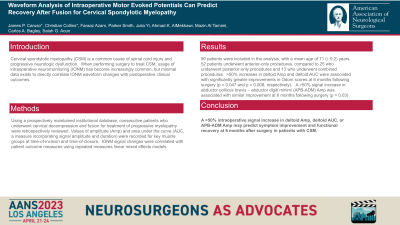Waveform Analysis of Intraoperative Motor Evoked Potentials Can Predict Recovery After Fusion for Cervical Spondylotic Myelopathy
Friday, April 21, 2023


James Caruso (he/him/his)
Resident Physician
UT Southwestern Department of Neurological Surgery
Dallas, Texas, United States
ePoster Presenter(s)
Introduction: Cervical spondylotic myelopathy (CSM) is a common cause of spinal cord injury and progressive neurologic dysfunction. When performing surgery to treat CSM, usage of intraoperative neuromonitoring (IONM) has become increasingly common, but minimal data exists to directly correlate IONM waveform changes with postoperative clinical outcomes.
Methods: Using a prospectively maintained institutional database, consecutive patients who underwent cervical decompression and fusion for treatment of progressive myelopathy were retrospectively reviewed. Values of amplitude (Amp) and area under the curve (AUC, a measure incorporating signal amplitude and duration) were recorded for key muscle groups at time-of-incision and time-of-closure. IONM signal changes were correlated with patient outcome measures using repeated measures linear mixed effects models.
Results: 90 patients were included in the analysis, with a mean age of 71 ( 9.2) years. 52 patients underwent anterior-only procedures, compared to 25 who underwent posterior-only procedures and 13 who underwent combined procedures. >50% increases in deltoid Amp and deltoid AUC were associated with significantly greater improvements in Odom scores at 6 months following surgery (p = 0.047 and p = 0.008, respectively). A >50% signal increase in abductor pollicis brevis – abductor digiti minimi (APB-ADM) Amp was associated with similar improvement at 6 months following surgery (p = 0.03)
Conclusion : A >50% intraoperative signal increase in deltoid Amp, deltoid AUC, or APB-ADM Amp may predict symptom improvement and functional recovery at 6 months after surgery in patients with CSM.
Methods: Using a prospectively maintained institutional database, consecutive patients who underwent cervical decompression and fusion for treatment of progressive myelopathy were retrospectively reviewed. Values of amplitude (Amp) and area under the curve (AUC, a measure incorporating signal amplitude and duration) were recorded for key muscle groups at time-of-incision and time-of-closure. IONM signal changes were correlated with patient outcome measures using repeated measures linear mixed effects models.
Results: 90 patients were included in the analysis, with a mean age of 71 ( 9.2) years. 52 patients underwent anterior-only procedures, compared to 25 who underwent posterior-only procedures and 13 who underwent combined procedures. >50% increases in deltoid Amp and deltoid AUC were associated with significantly greater improvements in Odom scores at 6 months following surgery (p = 0.047 and p = 0.008, respectively). A >50% signal increase in abductor pollicis brevis – abductor digiti minimi (APB-ADM) Amp was associated with similar improvement at 6 months following surgery (p = 0.03)
Conclusion : A >50% intraoperative signal increase in deltoid Amp, deltoid AUC, or APB-ADM Amp may predict symptom improvement and functional recovery at 6 months after surgery in patients with CSM.
